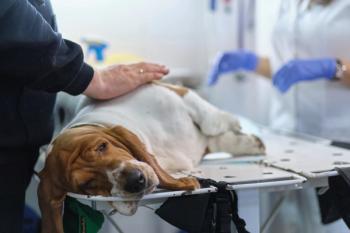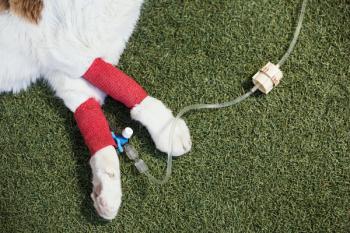
Thymoma in an 11-year-old dog: Surgery perspective
Dr. Christian Latimer provides the surgery perspective on this thymoma case.
Surgery is the recommended treatment for noninvasive thymomas in small animals, and thoracic computed tomography is ideal for determining the size and invasiveness of the tumor prior to surgery. The surgical approach is by using a median sternotomy (Figure 1), but a lateral thoracotomy can often suffice (Figures 2 & 3).1,2
Figure 1. Surgical view of a ventral sternotomy procedure for removal of a thymoma in a dog (not the patient in this case). (Photo courtesy of Karen M. Tobias, DVM, MS, DACVS.)
Figure 2. Thymoma after en bloc removal (not the patient in this case). (Photo courtesy of Karen M. Tobias, DVM, MS, DACVS.)
Figure 3. Note the intimate association of the tumor with the large vessels (not the patient in this case). (Photo courtesy of Karen M. Tobias, DVM, MS, DACVS.)
Dr. Christian LatimerIntraoperative complications include hemorrhage, unilateral phrenic nerve section and cardiac arrest.1 In a study, unilateral phrenic nerve section occurred in 18% of dogs, but that did not affect survival time.1 Postoperative complications include aspiration pneumonia, surgical site infection, hypocalcemia requiring treatment, seroma formation at the surgical site, and recurrence.1
Thoracoscopic resection of thymoma has also been reported.3-5 In a study, conversion to an open thoracic procedure was required for two out of 18 cases.3 In one case, the conversion was due to severe hemorrhage, and in the other case, the conversion was due to the large size of the mass as well as adhesions detected during surgery.3 Portal-site metastasis has been reported in a dog six and a half months after thoracoscopic-assisted removal of a malignant thymoma.5
Dogs treated surgically have a median survival time of 635 to 790 days, compared with a median survival time of 76 days for dogs not treated surgically.1,2 Recurrence is reported to be as high as 17%, but prognosis is reported to be good for dogs undergoing a second surgery.1
No difference in survival time was found between dogs with and without myasthenia gravis or megaesophagus in one study.1 However, median survival time after thoracoscopic resection of thymoma in dogs with concurrent myasthenia gravis and megaesophagus was just 20 days in another study.3 Dogs with thymoma without paraneoplastic syndrome in this study survived for 60 days or more, and none of these dogs died of disease-related causes.3
References
1. Robat CS, Cesario L, Gaeta R, et al. Clinical features, treatment options, and outcome in dogs with thymoma: 116 cases (1999-2010). J Am Vet Med Assoc 2013;243(10):1448-1454.
2. Zitz JC, Birchard SJ, Couto GC, et al. Results of excision of thymoma in cats and dogs: 20 cases (1984-2005). J Am Vet Med Assoc 2008;232:1186-1192.
3. Maclever MA, Case JB, Monet EL, et al. Video-assisted extirpation of cranial mediastinal masses in dogs: 18 cases (2009-2014). J Am Vet Med Assoc 2017;250(11):1283-1290.
4. Mayhew PD, Friedberg JS. Video-assisted thoracoscopic resection of noninvasive thymomas using one-lung ventilation in two dogs. Vet Surg 2008;37:756-762.
5. Alwen SG, Culp WT, Szivek A, et al. Portal site metastasis after thoracoscopic resection of a cranial mediastinal mass in a dog. J Am Vet Med Assoc 2015;247(7):793-800.
Newsletter
From exam room tips to practice management insights, get trusted veterinary news delivered straight to your inbox—subscribe to dvm360.



